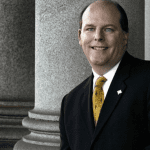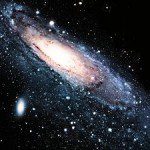Hello everyone. It’s been a while since I’ve published here regularly, but I look forward to getting started again. The creative agency I launched, Polymath Innovations, has expanded dramatically and we’ve had many wonderful clients and projects. At an Oxford event last year, we worked with BioLogos to develop videos now housed at Patheos here — be sure to check out the feature. I’ll especially include this video, since it relates to the guest post below: And with that, I’d like to welcome our guest blogger, Andy Walsh, courtesy of the Emerging Scholars Network. Andy is Chief Science Officer at Health Monitoring Systems. He has a Ph.D. in Molecular Microbiology and Immunology from Johns Hopkins Bloomberg School of Public Health (2005). More information in the bio below.
*
Before Darwin, There Was Adam
The origin of species; that’s what brought us all here. Charles Darwin’s seminal book offers an account of where species came from; we’re still left discussing whether it is the same narrative as Genesis 1 or an entirely separate sequence of events. Before Darwin, one could have had a similar discussion about Genesis 1 and Genesis 2; are they complementary or contradictory accounts of the order in which species came to be? Well, what if Genesis 2 actually is the account of the origin of species, only not until the second half of verse 19?
“The Lord God formed out of the ground every living animal of the field and every bird of the air. He brought them to the man to see what he would name them, and whatever the man called each living creature, that was its name.” Genesis 2:19 NET, emphasis added
Naming animals is the very first job God gives to Adam. This activity is Adam’s first opportunity to collaborate with God, on a small scale, in the act of creation. Creation is described in Genesis 1 as speaking order into chaos. Formerly a shapeless void, the world is organized by God’s words. God then gives Adam an opportunity to organize his world with words of Adam’s choosing. Perhaps Adam is afforded this privilege because he was made in God’s image, or perhaps this is Adam’s first opportunity to fulfill that commission.
In naming those animals, Adam becomes the first scientist. Science is the process of making sense of the world around us. Scientists observe that world, and then create descriptions to organize those observations in order to understand them. Sometimes that involves creating new language, just as Adam would have. Over time, those descriptions become more precise and more complex; often, they are expressed in mathematics, a language invented to accommodate very compact descriptions of the complex in precise terms. Those descriptions transform the very way that we think about the world (how hard it is to be convinced that your sniffles are the result of a rhinovirus infection and not the ambient temperature when cold is right there in the name!), and even transform the world itself by making it possible to describe and then create new technologies. These transformations are rooted in the language innovations of those organizing descriptions.
If Adam was the first scientist, what was his discipline? Would it surprise you to learn that Adam was the first evolutionary biologist? He initiated the process of deciding how to organize the animals, and in doing so he was the first to participate in one of the central activities of evolutionary biology. That’s a discipline we usually associate with “how” questions. How did the different species we observe come to exist? How did life begin? And so forth. These are the questions Darwin sought to answer, and evolutionary biologists continue to add details to those answers today. Yet they depend on even more fundamental questions. What is a species? What is a living organism?
What choices did Adam have when naming the animals? The details in Genesis are scant, but it seems clear that God gave Adam substantial freedom. Maybe Adam gave each individual a unique name – Niels and Rocket and Shadowfax – or maybe he kept things very simple – two-leggers, four-leggers, flyers, etc. We don’t know what he chose; the exact details don’t matter and his naming scheme needn’t correspond to the one we currently use. The important point is that he was free to choose a naming scheme, an organizational system, and the choice he made would stand. And so the concept of grouping animals was introduced to the world, which would ultimately give us the idea of a species.
Of course, when Adam named the animals he didn’t affect their genomes, their breeding preferences, or any aspect of their biology. Aren’t those the features that really determine an animal’s species, not the name Adam gave them? Well, yes and no. Breeding compatibility and more recently genome composition are the criteria we commonly use to define species. The actual organisms we so label, however, may not care as much about those features as we do. Bacteria in particular defy these criteria; they don’t have mates and they do share genes – share like a sandwich, not like a common value – without caring much about what the recipient looks like. That doesn’t mean the concept of species is completely useless, or that it is disconnected from biological reality. It has proven very useful over the years; still, it may represent more of a choice than we commonly appreciate.
If Adam’s naming scheme was the first in a series of choices about how to organize living organisms, then it becomes clearer that evolutionary biology is as much about our “what” questions as the “how” questions. We observe a whole variety of individual organisms; that is true no matter how they came to be. We propose a system for organizing them. The tools of evolutionary biology then help us discern how well that system matches our observations. What organisms are at the boundaries of those categories? What new categories would help us organize our observations better? The answers we get help us to better frame some of our most fundamental questions. What does it mean to be alive? What is essential to be considered human?
The primary insight evolutionary biology provides for framing those fundamental questions is this: if you want to separate what is essential from what is coincidental, try a new context. New contexts will reveal what it is possible to part with, and what you have to hold onto. Different organisms in different contexts suggest the range of forms that life can inhabit. And in a striking convergence that suggests the same God is trying to teach us something through his world and his Word, this pattern is illustrated in the Bible as well. After Adam finishes his naming project, humanity is expressed in the new context of a female, perhaps stretching Adam’s concept of what it means to be human. In Acts, the Gospel is taken into a Gentile context where circumcision and dietary regulations are no longer considered essential. And in a delightfully self-referential way, evolutionary biology itself provides a new context for each of us to examine our theology and decide what parts are idiosyncratic what parts are essential.
*
 Andy Walsh has worn many hats in his life. He knows this is a dreadfully clichéd notion, but since it is also literally true he uses it anyway. Among his current metaphorical hats: husband of one wife, father of two elementary school students, reader of science fiction and science fact, enthusiast of contemporary symphonic music, and chief science officer. Previous metaphorical hats include: comp bio postdoc, molecular biology grad student, InterVarsity chapter president (that one came with a literal hat), music store clerk, house painter, and mosquito trapper. Among his more unique literal hats: British bobby, captain’s hats (of varying levels of authenticity) of several specific vessels, a deerstalker from 221B Baker St, and a railroad engineer’s cap. His monthly Science in Review is drawn from his weekly Science Corner posts — Wednesdays, 8am (Eastern) on the Emerging Scholars Network Blog.
Andy Walsh has worn many hats in his life. He knows this is a dreadfully clichéd notion, but since it is also literally true he uses it anyway. Among his current metaphorical hats: husband of one wife, father of two elementary school students, reader of science fiction and science fact, enthusiast of contemporary symphonic music, and chief science officer. Previous metaphorical hats include: comp bio postdoc, molecular biology grad student, InterVarsity chapter president (that one came with a literal hat), music store clerk, house painter, and mosquito trapper. Among his more unique literal hats: British bobby, captain’s hats (of varying levels of authenticity) of several specific vessels, a deerstalker from 221B Baker St, and a railroad engineer’s cap. His monthly Science in Review is drawn from his weekly Science Corner posts — Wednesdays, 8am (Eastern) on the Emerging Scholars Network Blog.
Again, be sure to check out the BioLogos Feature at Patheos, and come back tomorrow for my own reflections on the topic.
















